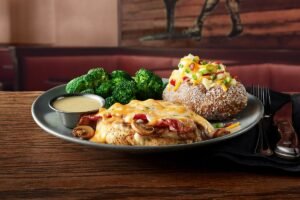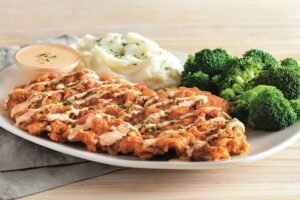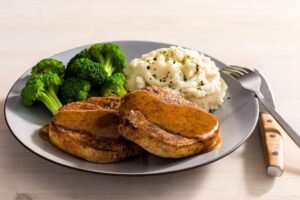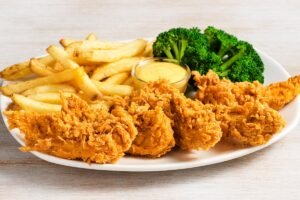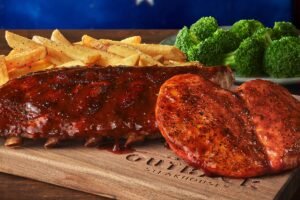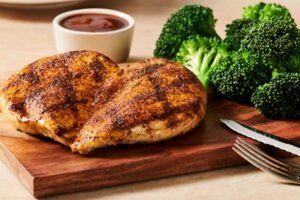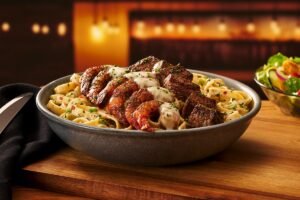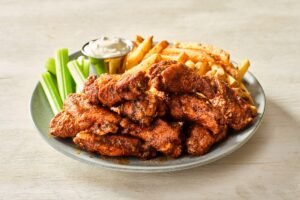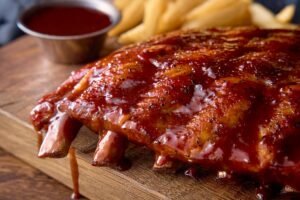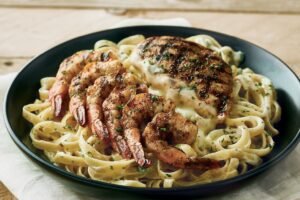Not everyone who walks into Outback wants a steak, and the restaurant knows it. This section of the menu exists for the friend who got dragged along, the person who had beef for lunch, or simply those who know that Outback’s non-steak game is surprisingly strong. These dishes pull their own weight, with some items developing cult followings that rival the popularity of any ribeye.
The “Chicken, Ribs, and More” section represents Outback’s evolution from steakhouse to full-spectrum casual dining. What started as obligatory alternatives has grown into a carefully crafted collection that accounts for 32% of all entrée sales – proof that sometimes the supporting cast deserves top billing.
The Alice Springs Chicken Phenomenon
Birth of a Classic
Alice Springs Chicken didn’t exist when Outback opened. It was created in 1992 by a line cook in Tampa who was messing around with leftover ingredients during a slow shift. The combination seemed random – grilled chicken with honey mustard, bacon, mushrooms, and cheese – but it worked so well that customers started requesting it off-menu.
By 1993, it was added system-wide and quickly became the most popular non-steak item. Today, it’s been copied by dozens of restaurant chains, but none match the original’s balance of flavors and textures.
Why It Works
The dish succeeds through calculated chaos. The honey mustard provides sweet and tangy notes, bacon adds salt and crunch, mushrooms bring umami earthiness, and the cheese blanket ties everything together. Each bite delivers different flavor combinations depending on which toppings you hit.
The chicken itself gets a 48-hour brine bath before grilling, ensuring it stays juicy even under the heat lamp. Most customers don’t realize the chicken is actually cooked separately from the toppings, then assembled to order – a labor-intensive process that maintains quality.
The Rib Revolution
Outback’s Smoking Process
Those baby back ribs aren’t just thrown on a grill and slathered with sauce. The process starts at 4 AM when kitchen staff begins the smoking process using a combination of hickory and oak woods. Ribs smoke at 225°F for exactly 4 hours, developing the pink smoke ring that BBQ enthusiasts recognize as properly prepared ribs.
After smoking, ribs get wrapped in aluminum foil with apple juice and brown sugar, then held in warming ovens at 170°F. When ordered, they hit the grill for caramelization, getting mopped with BBQ sauce three times in 2-minute intervals. The entire process, from raw to plate, takes nearly 6 hours.
The Sauce Situation
Outback’s BBQ sauce recipe includes 23 ingredients, with molasses, bourbon, and chipotle peppers playing starring roles. Each location makes sauce fresh every three days, despite having shelf-stable alternatives available. The sauce undergoes a 45-minute reduction process that concentrates flavors and develops the glossy sheen you see on finished ribs.
Fun fact: You can request ribs with sauce on the side or completely dry-rubbed. About 15% of rib orders come sauceless, preferred by BBQ purists who want to taste the meat and smoke without sauce interference.
Seafood That Doesn’t Suck at a Steakhouse
Fresh Fish Program
Outback’s seafood program operates differently than most casual dining chains. Rather than relying entirely on frozen product, they maintain relationships with regional suppliers for fresh fish delivery. Salmon arrives within 48 hours of catch, while shrimp comes both fresh (for grilled preparations) and frozen (for fried items).
The salmon undergoes a specific preparation process – skin-on cooking for moisture retention, finished skin-side up for presentation. The fish gets a light coating of olive oil and Outback seasoning, then grills at 425°F for 7-9 minutes depending on thickness.
The Coconut Shrimp Excellence
The coconut shrimp batter recipe took 18 months to perfect. The challenge was creating a coating that stayed crispy despite the moisture from both the shrimp and the coconut. The solution involved a three-step breading process: seasoned flour, beer batter, then coconut mixed with panko breadcrumbs.
The orange marmalade sauce started as a straight marmalade but evolved into a complex sauce with Creole seasoning, horseradish, and cayenne. Each batch requires exact temperature control during preparation – too hot and it breaks, too cool and it won’t emulsify properly.
Hidden Gems and Secret Knowledge
The Bloomin’ Fried Chicken Story
When Outback introduced Bloomin’ Fried Chicken in 2019, skeptics wondered if it was just a gimmick. The chicken breast gets pounded flat, marinated in buttermilk for 24 hours, then coated in the exact same seasoning blend used for the Bloomin’ Onion. The result tastes like someone figured out how to make an entire meal taste like the best part of the famous appetizer.
Initial test markets showed 40% attachment rate – meaning 40% of tables ordered at least one. That’s unprecedented for a new menu item. The challenge was operational – the chicken requires dedicated fryer space and longer cook times than anticipated.
Pasta Reality Check
The pasta dishes exist in a weird space on Outback’s menu. They’re competently executed but feel out of place, like finding sushi at a pizzeria. However, they serve a specific purpose – accommodating the one person in every group who doesn’t want traditional steakhouse fare.
The Queensland Pasta actually contains more shrimp and chicken per serving than similar dishes at Italian chains. Outback uses 6 oz. of protein compared to the industry standard 4 oz., justifying the steakhouse pricing for pasta.
Operational Challenges of Diversity
Kitchen Complexity
Every non-steak item adds complexity to kitchen operations. Chicken requires different cooking temperatures and times than beef. Ribs need dedicated smoking equipment. Seafood demands separate preparation areas to prevent cross-contamination.
During peak hours, the variety stresses kitchen capacity. A table ordering steak, ribs, chicken, and salmon means four different stations working simultaneously. This complexity explains why some items occasionally “aren’t available tonight” – it’s not that they’re out, but that the kitchen can’t handle the variety without compromising quality.
Training Requirements
Grill cooks undergo separate training modules for each protein type. Chicken requires understanding of carryover cooking and internal temperature variance. Ribs demand timing precision and sauce application technique. Seafood needs delicate handling and visual cue recognition for doneness.
The average Outback cook trains for 120 hours before working solo, with 40 of those hours dedicated to non-steak items. Compare that to burger chains where training might last 20 hours total.
The Truth About “And More”
The “and More” part of this menu section remains intentionally vague, allowing flexibility for limited-time offers and regional specialties. It’s marketing genius – promising something beyond the expected without committing to specifics.
This section has housed everything from wild boar chops to alligator bites over the years. Currently, it includes those pasta dishes that don’t quite fit elsewhere and the occasional seafood special that appears seasonally.
Making the Most of This Menu Section
Order these items without apology. They’re not consolation prizes or inferior choices – they’re legitimate menu options that stand on their own merits. The Alice Springs Chicken might not have the prestige of a porterhouse, but it delivers satisfaction that rivals any steak.
Consider these dishes for takeout. Unlike steaks that suffer during transport, items like ribs and fried chicken actually travel well. The sauces and toppings protect proteins from drying out during the journey home.
Don’t overlook lunch portions. Many of these items offer lunch-sized versions at significant savings. The lunch portion Alice Springs Chicken provides nearly identical toppings on a slightly smaller breast for $6 less.
Final Verdict
The “Chicken, Ribs, and More” section proves that Outback transcended its steakhouse origins to become something more versatile. These dishes don’t exist merely to accommodate non-beef eaters – they’re destination-worthy options that happen to share menu space with excellent steaks.
Whether you’re craving the sweet-savory complexity of Alice Springs Chicken, the primal satisfaction of smoke-kissed ribs, or the surprising excellence of coconut shrimp at a steakhouse, this menu section delivers. It represents Outback’s recognition that great dining isn’t about limiting options but about executing everything with equal commitment to quality.
The next time someone suggests Outback and you’re not feeling steak, don’t settle – explore. These dishes earned their menu placement through decades of refinement and millions of satisfied customers who discovered that sometimes the best thing at a steakhouse isn’t steak at all.
